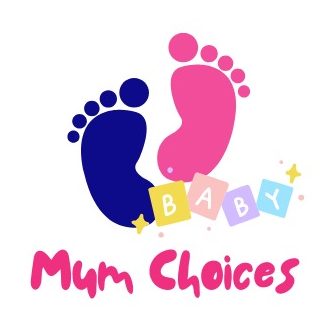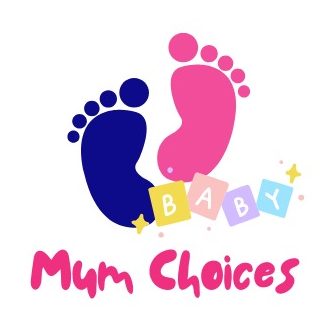Picture this: It’s 3 AM, you’re bleary-eyed from another diaper change. Suddenly you’re haunted by that question—‘Am I making the right choice for my baby… and the planet?’
The cloth vs. disposable diaper debate isn’t just about leaks and laundry. It’s a tug-of-war between:
- Your sanity (who has time for endless washing?),
- Your wallet (can you really afford $1,000+ on diapers?),
- Your conscience (what about the 20 billion disposables clogging landfills yearly?).
So, who should use cloth diapers vs disposable diapers?
As a mom, I understand the challenges of choosing the right diaper for your baby.
Unfortunately, the answer isn’t as simple as “eco-friendly vs. convenient.” Both have hidden costs, surprising benefits, and trade-offs that many parents don’t realize. There’s no ‘perfect’ diaper—only the one that fits your unique needs.
So how do you decide? Your choice depends on key factors that most diaper guides overlook.
In this guide, I’ll break down:
✔ The pros and cons of both cloth and disposable diapers—so you know exactly what to expect.
✔ Who benefits most from each type based on lifestyle, cost, and practicality.
✔ A side-by-side comparison to help you make the best decision for your family.
By the end, you’ll have a clear, confident decision that fits your needs—whether you’re a busy parent, an eco-conscious mom, or somewhere in between.
Let’s dive in!
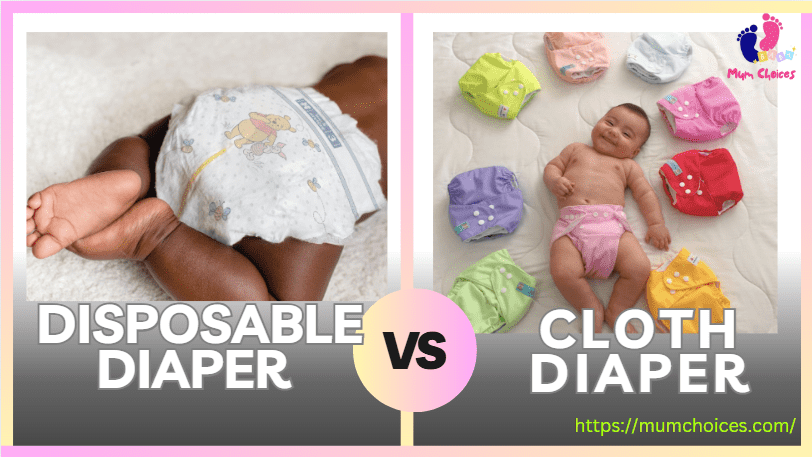
Cloth Diaper
Below, we’ll explore what they are, what they’re made of, their key properties, and how they function.
What is a cloth diaper?
A cloth diaper is a reusable diaper made from soft fabric. It is absorbent, so it can soak up your baby’s waste. Unlike disposable diapers, you wash and reuse cloth diapers. You don’t throw them away. Cloth diapers come in different styles and sizes. They are often chosen because they are eco-friendly. They are also cost-effective in the long run.
What is a cloth diaper made of?
Cloth diapers are made from different fabrics. Some common ones are:
- Cotton: Soft, breathable, and absorbs well.
- Bamboo: Soft, absorbent, and helps fight bacteria.
- Hemp: Strong, absorbent, and used with other fabrics.
- Microfiber: Absorbs well but needs cotton or bamboo for comfort.
- Fleece: Used outside to keep moisture in and stop leaks.
What are cloth diaper properties?
Cloth diapers have several important properties:
- Absorbent: They hold moisture and keep your baby dry for hours.
- Breathable: They allow air to flow, which helps reduce rashes.
- Reusable: You can wash and reuse them, which is better for the planet.
- Adjustable: Many have snaps or velcro to fit babies of all sizes.
- Soft: The materials feel gentle on your baby’s skin.
What is a cloth diaper’s function?
The main job of a cloth diaper is to soak up and hold pee and poop. It keeps your baby dry and comfy. Cloth diapers also help stop leaks and protect the skin. When the diaper gets dirty, you wash it and use it again. This helps reduce waste.
Pros and Cons of Cloth Diapers
Cloth diapers sound like a dream—eco-friendly, budget-conscious, and gentle on baby’s skin. But let’s be real: They also mean extra laundry, a learning curve, and upfront costs. So, are they the right fit for your family? Let’s break it down.
Pros of Cloth Diapers
- Saves money – Buy once, use many times. Good for multiple kids.
- Eco-friendly – No waste in landfills. Wash and reuse.
- Soft on skin – Made from natural fabrics. No harsh chemicals.
- Custom fit – Add inserts for more absorbency when needed.
- Breathable – Lets air flow. Helps prevent rashes.
- Cute designs – Comes in many colors and patterns.
- Less messy – Snug fit helps stop leaks and blowouts.
- Can resell – Sell, donate, or save for another baby.
Cons of Cloth Diapers
- High upfront cost – You pay more at first.
- More laundry – Need washing after every use.
- Takes time – Washing, drying, and folding add work.
- Less absorbent – Needs more changes than disposables.
- Bulky fit – Can be bigger under clothes.
- Leaks happen – Needs proper fit and inserts.
- Not as travel-friendly – Carrying dirty diapers is a hassle.
- Uses water and energy – Washing increases utility bills.
Disposable Diaper
Here is all about disposable diaper:
What is a disposable diaper?
A disposable diaper is used once and then thrown away. It is made for convenience because you don’t need to wash or reuse it. After it gets wet or dirty, you toss it in the trash.
What are disposable diapers made of?
Disposable diapers are made from several materials, including:
- Absorbent core: This material absorbs liquid and keeps your baby dry.
- Fluff pulp: Soft wood fibers absorb and hold moisture in the diaper.
- Polyester and polyethylene: These materials form the outer layer to prevent leaks.
- Nonwoven fabric: A soft inner layer touches your baby’s skin.
- Elastics: These stretch around the legs and waist. Thus, they keep the diaper snug and stop leaks.
What are disposable diaper properties?
Disposable diapers have several key properties:
- Highly absorbent: They soak up a lot of liquid and keep your baby dry.
- Leakproof: The outer layer and elastics stop leaks.
- Convenient: Just use and toss them—no washing needed.
- Soft and comfortable: The inner lining is gentle on your baby’s skin.
- Lightweight: They’re absorbent but still light and not bulky.
What is a disposable diaper’s function?
The main job of a disposable diaper is to soak up and hold your baby’s pee and poop. It keeps your baby dry and comfortable. It also helps prevent leaks and protects your baby’s skin from moisture. Once it’s full, you throw it away and put on a fresh one.
Pros and Cons of Disposable Diapers
Let’s break down the good, and the bad.
Pros of Disposable Diapers
- Easy to use – No washing, just toss after use.
- Super absorbent – Keeps babies dry longer.
- Less leakage – Snug fit helps prevent messes.
- Great for travel – No need to carry dirty diapers.
- Thin and lightweight – Fits easily under clothes.
- Saves time – No extra work like washing and drying.
- Wide availability – Found in most stores.
- Comes in all sizes – Fits newborns to toddlers.
Cons of Disposable Diapers
- Costs add up – Buying diapers for years gets expensive.
- Bad for the planet – Millions end up in landfills.
- May cause rashes – Some babies react to chemicals.
- Creates more trash – Needs frequent disposal.
- Not breathable – Can trap heat and moisture.
- One-time use – You throw them away after each change.
- Ongoing expense – No way to reuse or resell.
- Can leak – Fit and quality affect performance.
Choosing Between Cloth and Disposable Diapers
Benefits of Cloth Diapers Over Disposable
Cloth diapers are great for the planet. Since they are reusable, they cut down on waste. Unlike disposables, they don’t pile up in landfills.
While cloth diapers cost more at first, they save money over time. In our tests, families saved $1,500 to $2,000.
Cloth diapers also help prevent rashes. They let air flow and have no harsh chemicals. This keeps your baby’s skin happy and healthy.
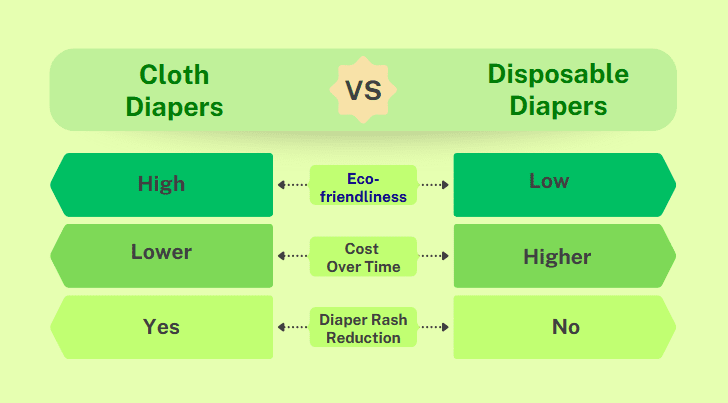
Disadvantage of Using Cloth Diapers Over Disposable Cloths
Cloth diapers have some downsides too. One issue is the need for frequent washing. This means more laundry, which can be time-consuming.
The initial cost is also higher. This might be a concern for some families.
Traveling with cloth diapers can be tricky. You need to carry them and store them until they can be washed. This can be inconvenient on the go.
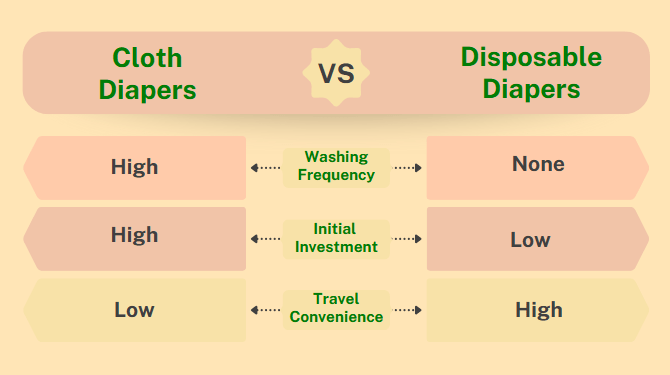
Health Considerations in Diaper Selection
- Cloth diapers help some babies avoid skin rashes.
- They can be bulky and affect baby’s movement.
- Regular changes are needed with all types of diapers.
Skin Health and Allergies
Cloth diapers are good for your baby’s skin. They have fewer chemicals than disposable diapers. Chemicals can irritate sensitive skin.
Many parents find cloth diapers help reduce rashes. They have fewer chemicals and let the skin breathe better.
But if cloth diapers aren’t washed well, they can cause irritations. This can lead to skin problems.
Studies don’t say if cloth or disposable diapers cause more rashes. Parents should watch how their baby’s skin reacts to each diaper.
Doctors say cloth diapers have benefits. They stress that cleaning them well is important. Changing diapers often also helps avoid skin problems.
Impact on Baby’s Physical Development
Diapers can affect how babies move. Disposable diapers are usually thicker than cloth diapers. Cloth diapers are thinner, so babies can move easier. This is important when babies start crawling or walking. The diaper should fit well but not be too tight.
Some studies suggest that thick diapers might slow down walking. But more research is needed to be sure.
It’s important to change diapers every 2-3 hours. This keeps babies clean and happy. Changing them on time helps avoid problems with movement or discomfort.
Chemical Exposure and Safety Concerns
Disposable diapers have chemicals. Chlorine and polyacrylate are two of them. These can irritate the skin. They may also cause breathing problems. Parents are worried about chemicals. So, they want safer options.
Some choose organic cloth diapers as a more natural choice for their baby.
Here’s a comparison chart to highlight the chemical components in cloth vs. disposable diapers:
| Chemical Component | Cloth Diapers | Disposable Diapers |
| Chlorine | No | Yes |
| Polyacrylate | No | Yes |
| Fragrances | No | Yes (sometimes) |
| Dyes | No | Yes |
| Sodium Polyacrylate | No | Yes |
| Toxins | No | Yes (possible traces) |
| Organic Materials | Yes (if organic) | No |
Cost Analysis of Cloth vs Disposable Diapers: Which Saves More Money?
- Cloth diapers save you money in the long run.
- Disposables need to be bought often, which adds up.
- Cloth diapers became less popular because they take more time to clean.
Long-term Cost Savings with Cloth
Cloth diapers require a bigger upfront investment. Parents spend more at first compared to disposables. A full set costs between $200 and $500, depending on the brand and type. But, this initial cost is usually made up over time. You don’t have to buy new diapers every week.
The materials in cloth diapers are strong. They last for years if you care for them well. Most are made from cotton, hemp, or bamboo. These materials can handle many washes and wear. Because of this, parents can use the same set for their first child and even for younger siblings.
Another benefit is that you can resell or pass on cloth diapers. When your baby outgrows them, you can sell them or give them to a friend. There are many community groups, both local and online, where parents buy and sell second-hand baby items.
Expense of Disposable Diapers
Disposable diapers need to be bought often. Each diaper may cost just a few cents, but with many changes, the costs add up fast. A baby uses 2,500 to 3,000 diapers in the first year, which is a lot of money.
Parents also need to restock diapers regularly. This means going to the store or ordering online. Subscription services like Amazon Family give discounts. But you still have to pay every month.
Many parents avoid cloth diapers because they are more work. Modern life leaves less time for washing. Disposable diapers became popular because they are easier and save time.
Why do people not use cloth diapers anymore?
Cloth diapers are used less today for a few reasons. Over time, consumer habits have changed. Fewer people now pick reusable options. Disposable diapers became popular in the 1940s and 1950s. They were easy and convenient.
Washing cloth diapers is a big concern for many parents. Busy families may not have time to wash them often. In cities, it can be hard to find places to wash. This makes cloth diapers harder to use. For these families, disposables are easier.
People also have negative views of cloth diapers. Parents worry about diaper rash and extra cleaning. They also worry about the high cost at first. But with the right washing and good fabric, you can solve most of these problems.
Environmental Impact of Diaper Choices: Which is More Sustainable?
- Cloth diapers help cut down on waste.
- Disposable diapers fill up landfills quickly.
Cloth Diapers and Sustainability
- Reduction in Waste Generation
Cloth diapers are much less wasteful. You can use them up to 200 times. This helps stop thousands of diapers from ending up in dumps. One child using cloth diapers can save about 2,200 disposable diapers each year. These diapers won’t go to landfills. This means fewer diapers add to the 3.5 million tons of waste from disposables in the U.S. each year. Experts point out this fact.
- Lower Carbon Footprint
Cloth diapers use much less energy and materials. They need about 20 times fewer raw materials. Cloth diapers also help reduce greenhouse gas emissions. This makes them a smart choice for eco-conscious parents . Studies show they save energy over time. This is important for parents who want to lower their carbon footprint when choosing diapers.
- Water and Energy Usage for Laundry
Cloth diapers help reduce landfill waste. But they need frequent washing. This can use more water and energy at home. Some people worry this extra use might cancel out the benefits. This concern is less if families use water-efficient washers and line dry when they can.
Disposable Diapers and Waste
- Significant Landfill Contribution
Disposable diapers are a big part of landfill waste. Around 27.5 billion are thrown away in the U.S. each year. This makes up about 4% of landfill content. This huge amount raises concerns about space and sustainability. With these numbers, it’s clear that reducing single-use diapers is important.
- Non-biodegradable Components
Disposable diapers have many parts that do not break down. These chemicals can harm the environment. Over time, they can leak into the soil and water. As diaper waste increases, these substances can hurt ecosystems.
- Long Decomposition Time
Disposable diapers take up to 500 years to break down. This makes them less sustainable. Waste from today will last for many generations. The long breakdown time has led critics and researchers to call for faster action. They want to find better diaper alternatives.
Cloth vs. Disposable Diapers: A Quick Side-by-Side Comparison
| Factor | Cloth Diapers | Disposable Diapers |
| Cost | High upfront cost, but cheaper in the long run | Low upfront cost, but expensive over time |
| Environmental Impact | Eco-friendly, reusable | Major contributor to landfill waste |
| Convenience | Requires washing, more effort | Easy, toss after use |
| Skin Health | Gentle, no chemicals | Can cause rashes, chemicals used |
| Absorbency | Good, but needs more frequent changing | Great for long wear, holds more liquid |
| Portability | Less convenient on the go | Super convenient for travel |
| Longevity | Can be used for multiple children | Disposable after use |
Diaper Choices Explained
In the next sections, I’ll show you who should use cloth diapers and who’s better off with disposables. You’ll find out what works best for your family.
Who Should Use Cloth Diapers?
Cloth Diapers Are Great For:
- Eco-Friendly Families
If you care about the planet, cloth diapers might be for you. They create less waste than disposables. But they do need water and energy for washing. Using cold water and line-drying helps reduce the impact.
- Budget-Savvy Parents
Cloth diapers save money over time. They can be reused for future kids. But they cost more upfront, usually between $300 and $800. If that fits your budget, they’re a smart investment.
- Parents of Babies with Sensitive Skin
Some babies get rashes from chemicals in disposables. Cloth diapers use natural fabrics like cotton and bamboo. These are soft and gentle. But they need frequent changes to keep your baby dry.
- Families with Laundry Access
Washing cloth diapers is easy if you have a washer at home. Some areas even offer diaper services. But if you don’t have in-unit laundry, washing them can be a hassle.
- Parents with More Than One Child
Cloth diapers are reusable. If you plan to have more kids, they can save you a lot of money. Instead of buying new diapers for each baby, you’ll already have a stash.
- Style-Loving Parents
Love picking out baby outfits? Cloth diapers come in cute colors and fun prints. You can match them with your baby’s clothes for a stylish touch.
Not Ideal for:
- Parents without easy access to laundry.
- Those who prefer convenience (e.g., daycare or travel).
- If upfront costs ($200-$600 for a set) seem too high.
Who Should Use Disposable Diapers?
Disposable Diapers Are Ideal For:
- Busy Parents
If you have a full schedule, disposables make life easier. No washing or folding—just use and toss. But they do cost more over time, around $70 to $100 per month.
- Families Who Travel Often
Traveling with cloth diapers is hard. Disposables are light and easy to carry. You can toss them when you’re done—no need to worry about washing.
- Parents Without Laundry Access
If you don’t have a washer and dryer at home, disposables are the better choice. No extra laundry means less stress.
- Parents on a Tight Budget (Short-Term)
Cloth diapers save money long-term. But if you need to spend less right now, disposables help. You buy as you go instead of paying a big cost upfront.
- Overnight Use
Disposables hold more liquid, which helps prevent leaks at night. They keep your baby dry longer, which means better sleep for everyone.
- Families Using Daycare
Most daycares prefer disposables. They’re easier for caregivers to change. If your baby goes to daycare, check their policy before choosing cloth diapers.
Not Ideal for:
- Parents worried about waste and the environment.
- Babies who get diaper rashes from chemicals in disposables.
- Families on a tight budget (costs add up over time).
The Best of Both Worlds
Many parents, including me, use both. Cloth diapers work great at home. They save money and reduce waste. But for travel or nights, disposables are easier. A mix of both gives you flexibility!
Final Recommendations
Choose Cloth If:
- You care about the environment.
- You have time and access to laundry.
- You plan to reuse diapers for other children.
Choose Disposables If:
- You need convenience and time savings.
- Your budget is tight right now.
- You travel often or use daycare.
Both options have benefits. The best choice depends on your needs, values, and lifestyle.
Comparing Diaper Brands
When comparing diaper brands, think about how well they work, how much they cost, and what your baby needs. Some brands are better at soaking up leaks, while others are more eco-friendly. Check out reviews from other parents to see which brands last longer and are gentle on your baby’s skin. Pick the one that works best for your family.
| Feature | Cloth Diaper Brands | Disposable Diaper Brands |
| Top Brand | BumGenius, Thirsties | Pampers, Huggies |
| User Rating | Generally positive | Generally positive |
| Price Range | $15-$25 per diaper | $0.20-$0.50 per diaper |
| Key Feature | Reusable and adjustable | Ready to use and highly absorbent |
FAQs: Cloth Diapers vs. Disposable Diapers
Here are answers to common questions:
Do disposable diapers cause diaper rash?
They can. Wetness and chemicals may irritate the skin. Change diapers often and use a gentle wipe to help prevent rashes.
How many cloth diapers do I need?
About 20-30 is enough. If you wash them every two days, 24 should work well.
Can I use cloth diapers at night?
Yes! Use extra inserts or boosters to keep your baby dry longer.
Are there eco-friendly disposable diapers?
Yes! Some brands use plant-based materials. They break down faster and are better for the planet.
Final Verdict: Who Should Use Cloth Diapers vs Disposable Diapers?
Both cloth and disposable diapers have pros and cons. There is no one-size-fits-all winner. The best choice depends on your needs.
What matters most is making the choice that works for your family. Think about your routine, budget, and how you feel about the environment.
Remember, your diaper choice can change as your baby grows. Some parents begin with disposables when their baby is small, then switch to cloth later. Others do it the other way around.
The key is being flexible and practical. Choose what works best for you while sticking to your budget and values. There is no right or wrong choice—just what fits your family.
Still unsure? Try a mix of both—cloth diapers at home, disposable diapersfor travel!
